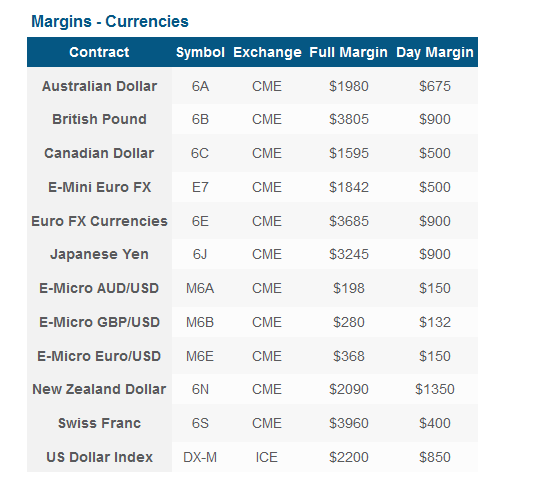Day trading margin emini s&p
Margin is essentially a loan that a brokerage firm extends to a client the trader or investor that is used for the purchase of trading instruments. Margin trading allows traders and investors to enter larger positions then they would otherwise be able to with a cash account because it provides leverage.
This leverage amplifies both wins and losses and, as such, margin should be used with caution and consideration. In addition to the leverage afforded, margin gives traders the ability to sell short. When traders sell short, they are attempting to profit from falling prices. Selling short requires traders to begin a trade by borrowing shares or contracts from a broker using margin and then selling them.
Traders buy back the shares or contracts known as "buying to cover" when they wish to close the trade. The concept of margin differs between stock, forex and futures because stock and forex trading involves purchasing something tangible a part of a company and a foreign currency and futures trading involves buying or selling a contract whose obligation will be met at a future date.
Margin for stock and forex trading is defined as borrowed money, whereas futures margin is considered an initial deposit or an "earnest money" deposit. Margin account holders pay interest on the amount of money used as margin. The margin interest rates vary depending on the current "broker call rate" or "call money rate" and the amount that is borrowed. Minimum Margin Brokerage firms require a minimum amount of funds in an account, or minimum margin , for traders to be able to use margin.
The minimum margin requirements for futures contracts, known as performance bonds, are set by the exchanges that offer these contracts.
What Are Emini Futures? Why Trade Emini Futures?
These minimums change frequently in response to market activity. The minimum margin requirements change in response to events such as: Dictionary Term Of The Day.
Low Daytrade Futures Margins for Emini Traders
A measure of what it costs an investment company to operate a mutual fund. Latest Videos PeerStreet Offers New Way to Bet on Housing New to Buying Bitcoin?

This Mistake Could Cost You Guides Stock Basics Economics Basics Options Basics Exam Prep Series 7 Exam CFA Level 1 Series 65 Exam. Sophisticated content for financial advisors around investment strategies, industry trends, and advisor education.
Intermediate Guide To E-Mini Futures Contracts - Margin By Jean Folger Share.
How Money is Made as an Emini Day Trader - Samurai Trading Academy
Intermediate Guide To E-Mini Futures Contracts - Introduction Intermediate Guide To E-Mini Futures Contracts - Popular E-Mini Contracts Intermediate Guide To E-Mini Futures Contracts - Volume And Volatility Intermediate Guide To E-Mini Futures Contracts - Margin Intermediate Guide To E-Mini Futures Contracts - Rollover Dates And Expiration Intermediate Guide To E-Mini Futures Contracts - E-Mini Brokers Intermediate Guide To E-Mini Futures Contracts - Tax Advantages. Changing volatility Shifts in supply and demand Changes in fiscal policy Major geopolitical events Natural disasters In general, minimum margin rates decrease when daily price moves become less volatile and increase during periods of increased volatility.
Individual brokerage firms can require higher minimum margin requirements tighter restrictions than the exchanges set in order to limit their own risk exposure.
Goal: 500 dollars a day trading the emini futures using the RamBot and Tradeometer 1-2 contractsInitial Margin Initial margin is the margin that traders must pay for with their own money when initiating a position. Also known as futures requirement, these rates vary by contract, contract date and brokerage firm.
Initial margin is a percentage of the full contract value of a position and is used to ensure that traders have enough cash in their accounts to cover losses. Maintenance Margin Maintenance margin is the minimum value that must be maintained in a margin account.
As an example, imagine that a trader entered a position to buy go long the September ES when the contract was trading at The potential gains and losses of the position fluctuate every time the settlement price of the contract changes. The final gain or loss is determined when the position is closed or when the contract expires.
Buying On Margin and Maintenance Margin Margin Calls A margin call occurs if the account falls below the maintenance margin amount. A margin call is a demand from the brokerage firm that money be added to a trading account to meet the initial margin requirements.
If the demand is not met, the brokerage firm can close out any open positions in order to bring the account back up to the minimum value.
The brokerage firm can close the position s without notifying the client in advance. Even if the brokerage firm offers the trader time to increase the equity in the account, it can sell off positions without consulting the trader.

Traders may be able to avoid a margin call by closing out the losing position s. Important terminology regarding margin are shown in Figure 3. Figure 3 - Various margin terms. If a broker-dealer identifies a client as a " pattern day trader " anyone who executes four or more day trades within five business days , the broker-dealer may enforce special margin requirements on the client's day trading account s.

Margin Trading Risks Trading with margin involves a number of risks. The Financial Industry Regulatory Authority lists the followings risks of which traders and investors should be aware: The Risks A brokerage firm can force the sale of open positions to meet a margin call. The firm can close the positions with contacting the client.
The client is not entitled to choose which positions are closed to cover a margin call. The firm can increase its "house" maintenance requirements at any time and without advance notice.
Clients are not entitled to extensions on margin calls. Traders can lose more money than is deposited in a margin account. When an investor buys on margin, he or she pays a portion of the stock price — called the margin -- and borrows the rest from a stockbroker.
The purchased stocks then serve as collateral for A maintenance margin is the minimum amount of equity that must be kept in a margin account. An underused opportunity provided in an SEC rule can enhance returns and lower risk for spread traders. Investing on margin can be profitable but it's a risky play that needs care.
Margin loans, futures and ETF options can all mean better returns, but which one should you pick? You may participate in both a b and a k plan. However, certain restrictions may apply to the amount you can Generally speaking, the designation of beneficiary form dictates who receives the assets from the individual retirement Discover why consultant Ted Benna created k plans after noticing the Revenue Act of could be used to set up simple, Content Library Articles Terms Videos Guides Slideshows FAQs Calculators Chart Advisor Stock Analysis Stock Simulator FXtrader Exam Prep Quizzer Net Worth Calculator.
Work With Investopedia About Us Advertise With Us Write For Us Contact Us Careers. Get Free Newsletters Newsletters. All Rights Reserved Terms Of Use Privacy Policy.